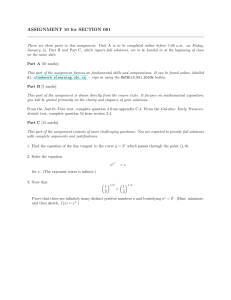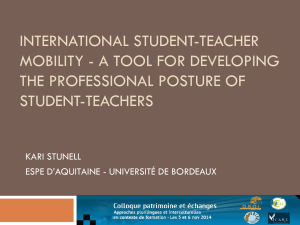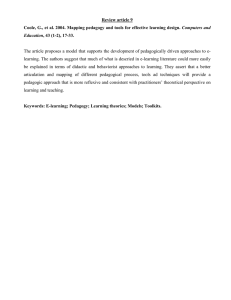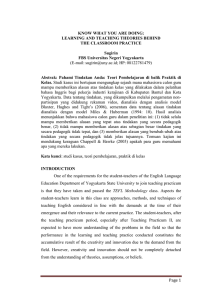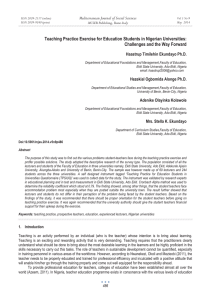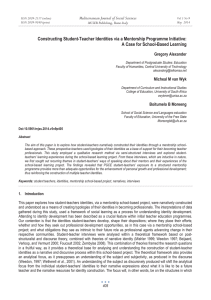E-Learning’s Impact on the Academic Performance of Student-Teachers: A Curriculum Lens
advertisement
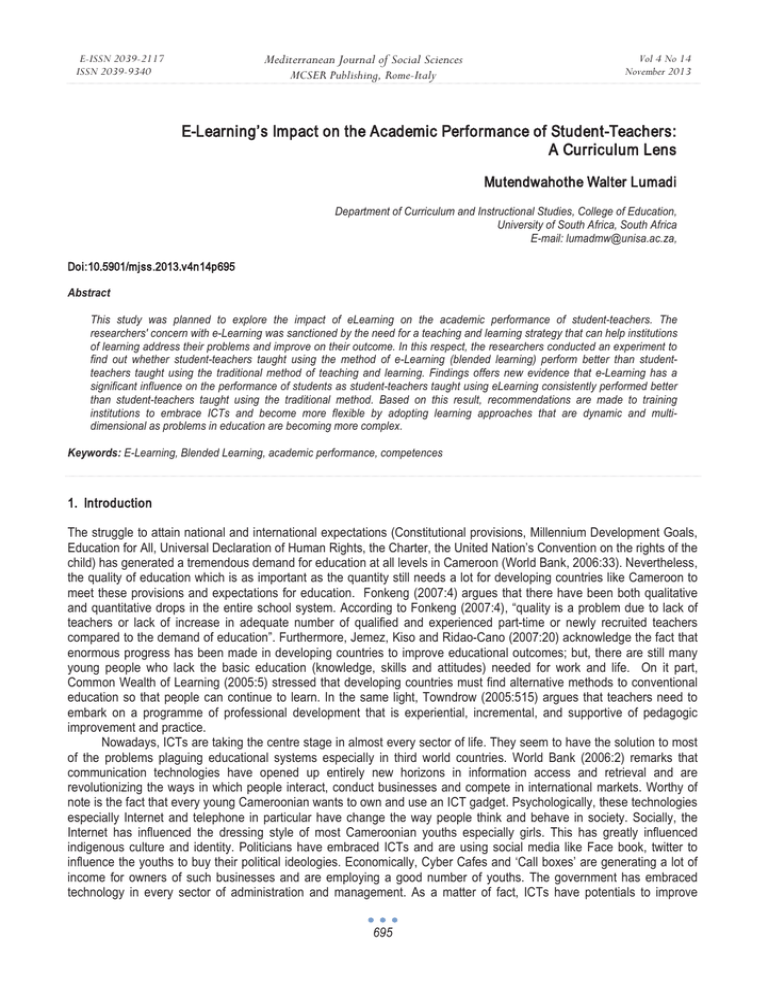
Mediterranean Journal of Social Sciences E-ISSN 2039-2117 ISSN 2039-9340 MCSER Publishing, Rome-Italy Vol 4 No 14 November 2013 E-Learning’s Impact on the Academic Performance of Student-Teachers: A Curriculum Lens Mutendwahothe Walter Lumadi Department of Curriculum and Instructional Studies, College of Education, University of South Africa, South Africa E-mail: lumadmw@unisa.ac.za, Doi:10.5901/mjss.2013.v4n14p695 Abstract This study was planned to explore the impact of eLearning on the academic performance of student-teachers. The researchers' concern with e-Learning was sanctioned by the need for a teaching and learning strategy that can help institutions of learning address their problems and improve on their outcome. In this respect, the researchers conducted an experiment to find out whether student-teachers taught using the method of e-Learning (blended learning) perform better than studentteachers taught using the traditional method of teaching and learning. Findings offers new evidence that e-Learning has a significant influence on the performance of students as student-teachers taught using eLearning consistently performed better than student-teachers taught using the traditional method. Based on this result, recommendations are made to training institutions to embrace ICTs and become more flexible by adopting learning approaches that are dynamic and multidimensional as problems in education are becoming more complex. Keywords: E-Learning, Blended Learning, academic performance, competences 1. Introduction The struggle to attain national and international expectations (Constitutional provisions, Millennium Development Goals, Education for All, Universal Declaration of Human Rights, the Charter, the United Nation’s Convention on the rights of the child) has generated a tremendous demand for education at all levels in Cameroon (World Bank, 2006:33). Nevertheless, the quality of education which is as important as the quantity still needs a lot for developing countries like Cameroon to meet these provisions and expectations for education. Fonkeng (2007:4) argues that there have been both qualitative and quantitative drops in the entire school system. According to Fonkeng (2007:4), “quality is a problem due to lack of teachers or lack of increase in adequate number of qualified and experienced part-time or newly recruited teachers compared to the demand of education”. Furthermore, Jemez, Kiso and Ridao-Cano (2007:20) acknowledge the fact that enormous progress has been made in developing countries to improve educational outcomes; but, there are still many young people who lack the basic education (knowledge, skills and attitudes) needed for work and life. On it part, Common Wealth of Learning (2005:5) stressed that developing countries must find alternative methods to conventional education so that people can continue to learn. In the same light, Towndrow (2005:515) argues that teachers need to embark on a programme of professional development that is experiential, incremental, and supportive of pedagogic improvement and practice. Nowadays, ICTs are taking the centre stage in almost every sector of life. They seem to have the solution to most of the problems plaguing educational systems especially in third world countries. World Bank (2006:2) remarks that communication technologies have opened up entirely new horizons in information access and retrieval and are revolutionizing the ways in which people interact, conduct businesses and compete in international markets. Worthy of note is the fact that every young Cameroonian wants to own and use an ICT gadget. Psychologically, these technologies especially Internet and telephone in particular have change the way people think and behave in society. Socially, the Internet has influenced the dressing style of most Cameroonian youths especially girls. This has greatly influenced indigenous culture and identity. Politicians have embraced ICTs and are using social media like Face book, twitter to influence the youths to buy their political ideologies. Economically, Cyber Cafes and ‘Call boxes’ are generating a lot of income for owners of such businesses and are employing a good number of youths. The government has embraced technology in every sector of administration and management. As a matter of fact, ICTs have potentials to improve 695 E-ISSN 2039-2117 ISSN 2039-9340 Mediterranean Journal of Social Sciences MCSER Publishing, Rome-Italy Vol 4 No 14 November 2013 teaching and learning as well as harbours a threat to education if poorly welcomed and used. Despite the growth in understanding ICTs in governance, business and in the development process, there is still much not known about eLearning especially ‘Blended learning’ in institutions of learning especially teacher education establishments. ELearning as a modern strategy for teaching and learning is multi-dimensional and dynamic, changing according to context, circumstances and interest. Thus, there are different expressions or typology of eLearning. Naidu (2003:8) defines e-Learning as “the systematic use of networked information and communication technology in teaching and learning”. According to C.O.L (2006), e-Learning and online learning are terms that have emerged to describe the application of Information and Communication Technologies (ICTs) to enhance distance education, implement open learning policies, make learning activities more flexible and enable those learning activities to be distributed among many learning venues. On his part, Perkinson (2005:104) defines e-Learning as “instructional content or learning experiences delivered or enabled by electronic technology”. Francoise Caillods in Bates (2001:9) holds that e-learning is more than just online distance education. E-Learning which is online or Web-based can be used in conjunction with ‘face-to-face’ teaching (Noe, 2002:263). This mode of eLearning is commonly called Blended Learning. Furthermore, Latchem (2012:13) asserts that Blended learning combines the traditional “classroom” or “face-toface” methods of teaching and learning with CD-ROM, Internet-based or mobile-Learning (mLearning) to achieve the most appropriate mix of presentation, interaction and “hands-on” learning. In fact, blended learning is the most popular form of e-Learning delivery today. A survey of traditional and blended learning at the National University of Rwanda carried out by Rwagasana and Stucki (2009:67) show that many traditional lecturers much prefer the use of the blended learning approach. Notwithstanding, Blended learning is emerging at a time institutions of learning are faced with a multiplicity of challenges such as insufficient pedagogic resources; and most importantly ineffective strategies and methods of teaching and learning; large classroom size; the introduction of new disciplines like Information and Communication Technology in the curriculum without a corresponding staff to teach amongst others. Students as well as teachers experiencing such difficult learning conditions find education a very frustrating activity and do not cope with its enormous demands. It is imperative to note that the problems in education today are becoming more complex and multi-dimensional due to the incessant penetration of ICTs in education. The direct result is poor academic performance and educational wastage. Thus, strategies to address these problems must be viewed in a multi-dimensional manner with respect to the context and the availability of means. It is on this note that this study sought to find out the impact of eLearning on the academic performance of students must especially student-teachers. 2. Literature Review The main theories or learning approaches underpinning this study include behaviourism, cognitivism and socioconstructivism. There has been a progressive shift from behaviourism, cognitive theories that emphasise individual thinkers and their cut off minds to theories that emphasize the social nature of learning. Behaviourists see learning as a change in observable behaviour caused by external stimuli in the environment. Bottino (2004:555) holds that the first ways in which the computer was used for educational purposes were influenced by behaviourism. Diessner (2008:134) argue that B. F Skinner is the most influential psychologists of the behaviourist movement of the 20th century. Skinner is remembered for his contribution in establishing a technology of teaching (‘teaching machine’), a device that used his principles of step-by-step instruction. According to Gifford and Enyedy (1999:189), educational technology designed from this perspective is best exemplified by Computer Assisted Instruction (CAI).They explained that CAI aims to make knowledge transfer more efficient primarily by ordering the sequence of content and by elaborating on its presentation. For example “simple to complex”, “known to unknown”, “near- to- far. CAI includes drill and practice programs and Tutorial systems. These programs help students to develop specific competencies and abilities. In their design, importance is ascribed to factors such as reinforcing memorisation, presenting objectives, specifying prerequisites, eliciting and assessing performance(Bottino 2004:556). Moreover, Crook (2001:20) points out that after behaviourism, cognitive psychology came to be the second theoretical force to shape modern accounts of learning. Jerome Bruner is remembered for his cognitive theory of instruction. Bruner (1956) cited in Santrock (2004:397) emphasized the concept of discovery learning by encouraging teachers to give students more opportunities to learn on their own. Another cognitive theory, which is relevant to ICTs and e-Learning in particular and has become for many cognitive psychologist, a popular approach to the study of learning is information – processing theory. Santrock (2004:247) stresses that information processing is concerned with how individuals analyse the many sources of information in the environment and make sense of these experiences. Central to 696 E-ISSN 2039-2117 ISSN 2039-9340 Mediterranean Journal of Social Sciences MCSER Publishing, Rome-Italy Vol 4 No 14 November 2013 this approach are the cognitive processes of memory and thinking (Hunt and Ellis, 2004:24). The physical brain is compared to the computer’s hardware and cognition to its software. More still, Crook (2001:20) argues that during the 1970s, behaviourism and cognitive psychology, defined the third theoretical alignment to be considered in learning called constructivism. Constructivism became influential within education through the work of Piaget as well as Vygotsky. Crook (2001:21) states that constructivism, must especially socio-constructivism confronted behaviourism and cognitivism which makes it more appealing. In the same light, Santrock (2004:51) assert that, like Piaget, Vygotsky (1896–1934) “believed that children actively construct their knowledge”. He was valued for his thinking now well known and widely respected, on such matters as learning as an essentially social process, the need to engage children in whole tasks that make sense to them, and the zone of proximal (or potential) development. The zone of proximal development is simply the difference between what a child can understand on his or her own and what he or she can potentially understand through interaction with others or learning support. Vygotsky suggests that teaching and learning are “social activities that take place between social actors in socially constructed situations” (Moore, 2000:15). Tchombe (2004:338) concludes that “how learning occurs and is supported has implications for the level of participation and the quality of the end product. 3. Research Methodology This study was conducted using the quasi experimental design. Fraenkel and Wallen (2000:283) points out clearly that experimental research is one of the most powerful research methodologies researchers can use. According to them, it is the best way to establish cause-and-effect relationship between variables. Amin (2005:220) points out that there are two main types of quasi-experimental designs: non equivalent group post-test designs and non equivalent group pre-testpost-test. This study employed the non equivalent group pre –test – post – test design. In this design, the subjects for the study were not randomly selected. Also subjects were assigned to two groups without any random selection. To establish if the two groups were initially different on the outcome measure, the two groups were pre-tested. After that, the treatment was given to one of the groups (experimental group). At the end of the treatment, a post-test was given to the two groups. It is worthy to note that some observation (participant observation) was involved in this study given that the researcher worked closely with the different groups as facilitator. As a matter of fact, this involvement in the study helped the researcher to collect some data of qualitative nature. It is also worthy to note that the type of eLearning experimented was “Blended Learning”. Also, the study was underpinned by the Competence-Based Approach strongly recommended by the Ministries of education in Cameroon. This study was carried out in the Higher Teacher Training College (H.T.T.C), University of Yaounde I in Cameroon. H.T.T.C Yaounde is a bilingual institution with English and French as the main official Languages used for instruction. It is commonly called E.N.S (Ecole Nomale Superieur de Yaounde). The institution has about 4745 students spread in different departments and levels (University of Yaounde I, 2012:78). The choice of this study area was sanctioned first of all by the fact that the institution has the basic infrastructure necessary for the research. The target population was made up of third-year (final year) Student-teachers. This study was carried out with 191 student-teachers. Of this number, 71 were made up of females scoring a percentage of (37.2 %) while 120 were males scoring a percentage of (62.8 %). Also, 68 student-teachers from the department of Physics, 67 from Chemistry, 25 studying German and 31 studying Spanish participated in the study. Furthermore, 67% of the student-teachers who participated in the experiment were below 25 years. Of the 191 student-teachers, 28.8% of them were between the ages of 25 and 30 years. Only 3.7% were above 29 years. This experiment was carried out with two main groups. The first group was a combined class that was made up of 56 level three students studying German and Spanish as foreign languages respectively in the department of foreign languages registered for the course EDI 309 (Educational Technology). This group constituted the experimental group. The second group was also a combined class that was made up of 135 level three students studying Chemistry and Physics as teaching subjects and registered for the course EDI 309. This group constituted the control group. Educational Technology (EDI 309) is a course offered by the department of Science of Education to all level three students in all the departments of the Higher Teacher Training College Yaounde. EDI309 was based on three main competences expected to be developed. These include general knowledge about ICTs in Cameroon, Usage of ICTs and Creativity (production). The aforementioned competences expected to be developed were grouped under modules. Each module was accompanied with Feedback (formative and summative evaluation), remediation and reinforcement. The modules were carefully designed by the researchers to suite the objectives of the course and the research. The programme took in to consideration the aspect of individual differences given that not every student could achieve the 697 E-ISSN 2039-2117 ISSN 2039-9340 Mediterranean Journal of Social Sciences MCSER Publishing, Rome-Italy Vol 4 No 14 November 2013 same competences at the same time. It was designed on the premise that the initial professional development of student-teachers was very important for teaching and learning with ICTs in the later years. The design of the programme took into account the needs and expectations that the institution has in respect to training. The course was subdivided into fourteen (14) units covering all the fourteen (14) weeks of the first semester (2012/2013 academic year). Each unit had duration of two hours of tutoring each week in school (face-to-face meeting). It is imperative to note that this study was guided by two assignments that constituted Test One and Test Two. The elements that constituted test one include the creation of emails; Online/offline registration and feedback; participation; attendance; respect of instructions and deadlines (20 marks). Test Two was based on group production and required the different sub-groups in each class to: 1. construct an instructional media or platform and; 2. describe how it can be used in teaching a specific concept or topic in their field of study. Test Two was marked on a total of 20 marks (design, presentation and description) In addition, the following resources were very essential for the success of the study: ¾ the right study environment; ¾ Internet access; ¾ Online Learning Platform: espalledi309@yahoogroups.com; ¾ Individual and group Email addresses (compulsory for all the students in the experimental group); ¾ Digital Camera; ¾ Video Projector; ¾ Telephone; ¾ Programme guide. ¾ Moderator/Web Manager: Researcher 3. 1 Description of the Experiment The purpose of the experiment was to find out whether student-teachers taught using the method of eLearning (Blended Learning) perform better than student-teachers taught using the traditional method of teaching. The independent variable was eLearning which created conditions for learning while the dependent variable was the academic performance of student teachers in educational technology. This was represented in terms of scores (results). The dependent variable also represented professional competences (knowledge, skills and attitudes) to be developed. Experimental Group In this group, student-teachers were given access to an electronic platform. The Blended learning mode (combination of face-to-face and Internet-based learning) was adopted in teaching and learning. Student-teachers in this group had the opportunity to meet ‘face-to-face’ with the lecturer during normal class time once a week. In order to proceed, the researcher created a Communication platform called espalledi309 thanks to yahoogroup. Secondly, students were asked to create email addresses and send to the researcher through which they can receive invitations to join the learning platform. The class agreed that this activity would carry two points on continuous assessment. Thirdly, the students were instructed on how to join the group by accepting invitations that were sent into their Electronic mail boxes (Inbox). A time limit was fixed for that activity. Eventually all the students received invitations and joined the platform. The goals and rules to be respected were agreed by all the members; members agreed not to send privates mails or discuss private issues in the platform, to respect one another in the group and focus on building an atmosphere of trust. Also the roles of members were clearly defined as the class was subdivided into 10 sub-groups. These groups were formed according to the class size and the order of names on the class list. Each group was expected to appoint a coordinator, a secretary and a disciplinarian. The duty of the coordinator was to ensure that the group work was accomplished and that all the members were active. The secretary ensured that all the assignments were typed and sent to the platform. The secretary was also the one to present the work to the class after production. The disciplinarian ensured that there was total discipline in the group. All the members were expected to be proactive especially in the conception, design and production of their didactic material. The presence of a study guide gave an orientation to the student-teacher, encouraging discovery learning and decreasing psychological difficulties. The presence of the online platform gave an orientation towards self learning, discussion with classmates and the researcher (collaborative learning) when studying a module. The platform offered students the opportunity to have discussions with friends and with the teacher. At each level, the researcher intervened to solicit participation and to moderate the discussion and also to conclude it. The 698 Mediterranean Journal of Social Sciences E-ISSN 2039-2117 ISSN 2039-9340 Vol 4 No 14 November 2013 MCSER Publishing, Rome-Italy teacher acted as moderator on-and-offline. Students, who did not have Internet at home, had the opportunity to carry out their studies and assignments in school since the school had wireless Internet connection. Control Group Unlike in the Experimental group, student-teachers in the control group had no access to an electronic platform. They received their lessons following the ‘face-to-face’ mode of delivery. In this group, the lecture, demonstration and illustration methods dominated in most of the lessons. This group helped the researchers to determine whether the use of e-Learning had an effect on the performance of student teachers. However both groups followed the same programme with similar activities taking into account the needs and expectations of the student-teachers, the expectations of the course and the institution. The course was taught in a way that students could acquire basic knowledge and skills needed for effective teaching and learning in the field (Basic education). Latchem (2012:9) as well as WBI (2007:117) describe basic education as the formal, non-formal and informal learning that meets basic learning needs and lays the foundation for all subsequent learning. 3.2 Method of Data Analysis It is worthy to note that the experiment generated data in terms of scores (First and Second Test). Both descriptive and inferential statistics were used to analyze the data. The experiment was conducted with two independent groups. This necessitated the use of the student t-test to compare the experimental effect between the two groups. Equally, the t-test and the one way-ANOVA were used to determine the variability of the marks of student-teachers by personal or sociodemographic characteristics (gender, age, fields of study). Data was logged into the computer and analyzed using the Statistical Package for Social Sciences (SPSS) version 20. 4. Findings and Discussion 4.1 Test One T-Test Table 1 Description of First Test Results in relation to Mean and Standard Deviation Marks for first test Group Experimental Group Control Group N 56 135 Mean 15.2679 14.1259 Std. Deviation 1.77345 1.89039 Std. Error Mean 0.23699 0.16270 Table 1.1 Independent Samples Test Levene's Test for t-test for Equality of Means Equality of Variances F Sig. T df Sig. (2-tailed) Equal variances Marks for assumed first test Equal variances not assumed 0.006 0.940 Mean Difference Std. Error Difference 3.869 189 0.000 1.14193 0.29519 3.972 109.115 0.000 1.14193 0.28746 The results show that on the average, the reported variability of the marks in the first test was significantly higher for the Experimental Group (M = 15.267, SD = 1.773) than for the Control Group (M = 14.125, SD = 1.890), t (191) = 3.869, p < 0.001, r = 0.27. The estimated size of the effect indicates that the difference in performance in the first test created by group was small and thus representing a substantial effect. 699 Mediterranean Journal of Social Sciences E-ISSN 2039-2117 ISSN 2039-9340 Vol 4 No 14 November 2013 MCSER Publishing, Rome-Italy 4.2 Test Two T-Test Table 2 Description of Second Test Results in relation to Mean and Standard Deviation Group Marks forExperimental Group second test Control Group N 56 135 Mean 16.0536 14.2519 Table 2.1 Independent Samples Test Levene's Test for Equality of Variances F Sig. Equal variances Marks assumed for second Equal variances test not assumed 0.368 Std. Deviation 1.34055 1.35337 Std. Error Mean 0.17914 0.11648 t-test for Equality of Means 0.545 T Df Sig. (2tailed) Mean Difference Std. Error Difference 8.399 189 0.000 1.80172 0.21453 8.432 103.728 0.000 1.80172 0.21368 The results show that on the average, the reported variability of the marks in the second test was significantly higher for the Experimental Group (M = 16.054, SD = 1.341 than for the Control Group (M = 14.252, SD = 1.353), t (191) = 3.869, p < 0.001, r = 0.5214. The estimated size of the effect indicates that the difference in performance in the second test created by group was significant and thus represents a substantial effect. 4.3 Test One and Test Two T-TEST Table 3 Description of Mean Marks in relation to Group for Test One and Two Group N Mean Std. Deviation Experimental Group 56 15.6607 1.20268 Mean Marks for the two tests Control Group 135 14.1889 1.50480 Std. Error Mean 0.16071 0.12951 Table 3.1 Independent Samples Test Levene's Test for Equality of Variances F Sig. Means Marks for the two tests Equal variances assumed Equal variances not assumed 3.412 0.066 t-test for Equality of Means T Df Sig. (2tailed) Mean Std. Error Difference Difference 6.505 189 0.000 1.47183 0.22626 7.131 127.551 0.000 1.47183 0.20640 The results show that on the average, the reported variability of the Mean marks between the first test and the second test was significantly higher for the Experimental Group (M = 15.660, SD = 1.202) than for the Control Group (M = 14.188, SD = 1.504), t (191) = 6.505, p < 0.001, r = 0.4280. The estimated size of the effect indicates that the difference in performance between the two groups was significant, and therefore represents a substantial effect. 700 E-ISSN 2039-2117 ISSN 2039-9340 Mediterranean Journal of Social Sciences MCSER Publishing, Rome-Italy Vol 4 No 14 November 2013 Fig 4.7 Representation of Student-teachers’ Results in Test One and Test Two The above chart clearly shows a significant difference between the results in the first test and the second test for both the Experimental group and the Control group. Fig 4.7 Representation of Student-teachers’ Results in Test One and Test Two using Time Series Chart The graph for the Experimental group (GE) shows a steady increase in results from the first test to the second test while the graph for the Control group (GC) indicates a slight increase in results from the first test to the second test. In all, both graphs show that the results of student-teachers in the Experimental group remained consistently higher than the results of student-teachers in the Control group. 701 E-ISSN 2039-2117 ISSN 2039-9340 Mediterranean Journal of Social Sciences MCSER Publishing, Rome-Italy Vol 4 No 14 November 2013 The results of the experiment revealed that on the average, the reported variability of the Mean marks between the first test and the second test was significantly higher for the Experimental Group (M = 15.660, SD = 1.202) than for the Control Group (M = 14.188, SD = 1.504), t(191) = 6.505, p < 0.001, r = 0.4280. The magnitude of the effect showed that the difference in performance between the two groups of student-teachers was significant. This finding offers new evidence that eLearning has a significant influence on the performance of student-teachers. This result is consistent with previous research by the behaviourists, cognitivists and the socio-constructivists whose research indicates that the use of technology in a defined environment or context facilitates the acquisition of competences. In addition, results showed that the field of study had a significant influence on the performance of studentteachers in the first test, F (2, 188) = 7.581, p < 0.001, Ȧ=0.30. This means that about 30% of the results in the first test could be explained by the field of study of the student-teachers. More still, findings of the second test showed that the field of study had a significant influence on the performance of student-teachers, F (3, 187) = 23.391, p < 0.001, Ȧ=0.5100. This means that about 51% of the results could be explained by the field of study of the student-teachers. This finding gives new proof that the effect of the treatment (eLearning) vary from one field of study to another. In the same light, the study revealed that student-teachers studying Arts subjects like Languages appreciate eLearning better than student-teachers studying Science subjects like Physics and Chemistry in Cameroon. Furthermore, the analysis of variance for the first test revealed that age group or category had a significant influence on the results of the student-teachers in the first test, F (2, 188) = 3.814, p < 0.05, Ȧ=0.17. The same analysis in the second test showed that age did not have a significant influence on the results of the student-teachers in educational technology (F (2, 188) = 0.424, p > 0.05). Also, when the differences in the Means and Standard Deviations in the various age groups was tested for its degree of significance, Levene's test and the analysis of variance revealed that the ages of the student-teachers did not have a significant effect on the results recorded in this experiment. More still, findings revealed that on the average, female student teachers performed better than their male counterparts. Also, when the difference in performance in the two tests (Test One and Test Two) was tested for its degree of significance, findings further revealed that gender had a significant effect in the results of the study. This result offers new evidence that gender plays a significant role in student-teachers appreciation of eLearning in Cameroon. It is worthy to note that the best three productions in terms of design, presentation and description came from the Experimental group. The group with the best production came from Group 3-Spanish with a total score of 18 on a scale of 20 marks. This group, made up of six members, produced a Compact Disk (CD) and a Flip chart on Pronunciation of the Spanish Alphabet that can be used by Form three students in Cameroon. The group that came second was Group 4 from the German class with a score of 18 on a total score of 20 marks. This group, made up of five members produced a Video CD on common vocabulary that can be used by beginners of the German Language. The group that came third was group 2-German with a total score of 17 on a scale of 20 marks. This group, made up of five members produced an Audio CD on common pronunciation in German. More still, comments and questions asked to the teacher as well as posted on the platform about the course showed that student-teachers in the Experimental group were more committed in acquiring the necessary competences expected to be developed. The researcher observed that student-teachers in the Experimental group enjoyed working as a group and as individuals. The discussions that happened in the classroom during face-to-face meetings and in the platform as they leave the classroom revealed that they had developed a more socio-constructive attitude towards problem-solving. It was equally observed that the student-teachers in this group had developed the attitude of sharing information that concerned them on the group. They made comments such as “I have learned a lot from the platform”, “I have learnt how to create my own group”, “I will use our group work during teaching practice”. As a matter of fact, they all appreciated the platform and asked questions about “what will happen to the platform after the course”. 5. Concluding Remarks In conclusion, eLearning more specifically blended learning has a significant impact on the performance of studentteachers. However, the educational system will not be able to support the incessant growth and penetration of ICTs in education without an effective initial professional development of student teachers that is based on these technologies. As a matter of fact ICT is the key to education for sustainable development. Teacher training institutions need to revise or change their training approaches, strategies and activities. They need to become more flexible by adopting more flexible learning approaches. Thus, researchers in the field of education must engage themselves into this kind of research for capacity building purposes. This kind of research will help institutions of learning and the country in particular to solve its current and future educational challenges. 702 E-ISSN 2039-2117 ISSN 2039-9340 Mediterranean Journal of Social Sciences MCSER Publishing, Rome-Italy Vol 4 No 14 November 2013 References Amin, E. M. (2005) Social Science Research: Conception, Methodology and Analysis. Makerere University Printery, Kampala Uganda Bates, T. (2005) Charting the Evolution of lifelong learning and Distance higher education: The role of research. In C. McIntosh (Ed) Perspectives on Distance Education, Lifelong Learning and Distance Higher Education. UNESCO/COL Bottino, M. R. (2004) The evolution of ICT - based learning environments: which perspectives for the school of the future? British Journal of Educational Technology. 35(5), 553-567 COL (2005) Open and Distance Learning for Development. Connections. COL, Vancouver, Canada. June 2005/Vol. 10, Number 2, pp1-16 COL (2006) Open and Distance Learning for Development. Connections. COL, Vancouver, Canada. June 2006/Vol. 11, Number 2, pp1-16 Crook, C. (2001) The Social Character of Knowing and Learning: implications of cultural psychology for educational technology. Journal of Information Technology for Teacher Education, Loughborough University, United Kingdom, 10(1 & 2), 19-36 Diessner, R. (2008) Classic Edition Sources: Human Development. McGraw-Hill Contemporary Learning Series. Fonkeng, E.G. (2007) The History of Education in Cameroon, 1844-2004. Edwin Mecler Press: New York. Frankel, J.R and Wallen, N.E. (2000) How to Design and Evaluate Research in Education. (4th edition). New York: MacGraw-Hill. Gifford, R. B. and Enyedy, D. N. (1999) Activity Centered Designs: Towards a Theoretic Framework for CSCL. Computer Support for Collaborative Learning (University of California at Berkeley), 189-197 Hunt R. R and Ellis, C. H. (2004) Fundamentals of Cognitive Psychology. Seven Edition, McGraw-Hill. Jimenez, E., Kiso, N., Ridao-Cano, C. (2007) Educational Second Chances for Youth, In World Bank Institute, Development Outreach, 9(2), 20-21. Latchem, C. (2012) Quality Assurance Tolkit for Open and Distance Non-Formal Education. C.O.L Moore, A. (2000) Teaching and Learning: Pedagogy, Curriculum and Culture. Routledge and Palmer: London. Naidu, S. (2003) ELearning: A Guide Book of Principles, Procedures and Practice. CEMCA (Commonwealth Educational Media Centre for Asia) Noe, R. (2002). Employee Training and Development. (2nd edition), McGraw-Hill. New York, Perkinson, R. (2005) Beyond Secondary Education: The promise of ICT for higher education and lifelong learning, In World Bank (Ed). E-Development: From Excitement to Effectiveness. (The World Bank, Washington), 101-125 Rwagasana, G., and Stucki, P. (2009) Strategic options and Results of Introducing Blended Learning at the National University of Rwanda. eLearning Africa 2009: 4th International conference on ICT for Development, Education and Training. ICWE GmbH: 6669 Santrock, J. W. (2004) Educational Psychology. (2nd edition), McGraw-Hill, New York. Tchombe, T.M. (2004) Psychological Parameters in Teaching, Presses Universitaires d Afrique. World Bank (2006) From Schooling Access to Learning Outcomes: An Unfinished Agenda, The World Bank, Washington DC. University of Yaounde I (2012) Annual Statistics of the University of Yaounde I. The University of Yaounde I. World Bank (2006) Global Issues for Global Citizens: An Introduction to Key Development Challenges. The World Bank, Washington DC. World Bank (2006) Information and Communication for Development: Global Trends and Policies. The World Bank, Washington DC. World Bank Institute (2006) Annual Report 2006: Developing Capacities in Countries. The World Bank, Washington DC. World Bank Institute (2007) Building Knowledge Economies: Advanced Strategies for Development. The World Bank, Washington DC. 703
